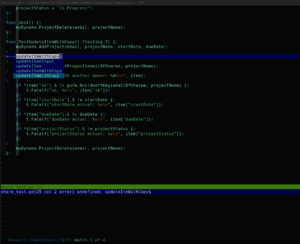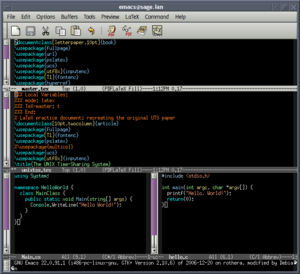Integrated development environment facts for kids
An integrated development environment (IDE) is a special computer program that helps people create other computer programs. Think of it like a workshop for building software. An IDE usually has three main tools: a source-code editor (where you write the code), tools to help you build your program, and a debugger (which helps you find and fix mistakes).
Some IDEs, like IntelliJ IDEA or Eclipse, even include the tools needed to turn your code into a working program (a compiler or interpreter). Others, like NetBeans, might need you to get those tools separately.
The line between an IDE and other software tools can be blurry. Sometimes, an IDE might also include tools to manage different versions of your code or help you design the look of your program (like buttons and menus). Many modern IDEs also help you see how different parts of your program connect, especially when you're building programs using object-oriented methods.
Contents
What is an IDE?
IDEs are designed to make it easier and faster for programmers to write software. They bring all the important tools together in one place, and these tools often look and work in similar ways. This means you do all your programming work within a single program. This is different from using many separate tools, like a simple text editor, a separate debugger, and a separate tool to build your program.
One main goal of an IDE is to reduce the time you spend setting up your tools. Instead of finding and connecting many different programs, the IDE gives you everything you need in one package. This can help programmers be more productive. For example, an IDE can check your code as you type. If you make a mistake, it can tell you right away, making it much faster to find and fix problems.
Some IDEs are made for a specific programming language, which means they have features that work perfectly with that language. However, many IDEs can work with multiple programming languages.
Even though most modern IDEs have a graphical look with windows and menus, older text-based IDEs were popular before graphical systems like Microsoft Windows became common. These older IDEs often used special keys or shortcuts to run commands.
A Brief History of IDEs
IDEs first became possible when people started programming using computer terminals. Before that, programs were often fed into computers using punched cards.
Dartmouth BASIC was one of the very first programming languages created with its own IDE. This IDE was part of the Dartmouth Time-Sharing System. It was based on text commands, not graphical menus, but it allowed programmers to edit, manage files, compile, debug, and run their programs all in one system. This was a big step towards modern IDEs.
Maestro I, developed by Softlab Munich, was the world's first truly integrated development environment for software. It was used by many programmers around the world in the 1970s and 1980s. One of the last Maestro I systems can now be found in a museum in Texas.
In 1995, a product called Softbench introduced the idea of "plug-ins" for IDEs. This meant you could add extra features to your IDE.
As of today, some of the most popular IDEs that people search for online include Visual Studio, Visual Studio Code, and Eclipse.
Key Features of IDEs
Highlighting Your Code
The editor in an IDE often uses syntax highlighting. This means it shows different parts of your code, like keywords or special commands, in different colors or with different text styles. This makes your code easier to read and helps you spot mistakes quickly.
Smart Code Completion
Code completion is a very helpful IDE feature that speeds up programming. As you type, the IDE can suggest words or lines of code you might want to use. Modern IDEs even have "intelligent" code completion that tries to guess what you're trying to do based on your code.
Reorganizing Code (Refactoring)
Advanced IDEs can help you with automated refactoring. This means the IDE can help you reorganize and clean up your code without changing what the program actually does. It's like tidying up your room to make it easier to find things, but for your code!
Tracking Changes (Version Control)
An IDE usually includes tools for version control. This helps you keep track of all the changes you make to your code over time. It's like having a save history for your project, so you can go back to an older version if you need to.
Finding and Fixing Mistakes (Debugging)
IDEs are also great for debugging. They have a built-in debugger that helps you find and fix errors in your code. You can set "breakpoints" in your code, which makes the program pause at certain points so you can see what's happening step-by-step.
Searching Through Code
IDEs can help you search through your code in different ways. You can search for specific words, or find where a certain part of your code is used. This is very useful in large projects.
Visual Programming
Visual programming is a way of creating programs by dragging and dropping visual blocks or diagrams instead of writing lines of text code. IDEs are often needed for this. For example, Visual Basic allows users to create applications by moving building blocks around to create flowcharts. This method is also popular with systems like Lego Mindstorms.
Supporting Many Languages
Some IDEs can support multiple programming languages. Examples include GNU Emacs, IntelliJ IDEA, Eclipse, and NetBeans.
Often, support for different languages is added through "plugins." These are like small apps you can install into your IDE. For instance, Flycheck is a plugin for GNU Emacs that checks syntax for many languages.
IDEs on Different Computers
On Unix-like systems (like Linux), programmers often combine many small tools to create their own development environment. The entire Unix system can act like an IDE. Tools like GNU Compiler Collection (GCC) and GNU Debugger (GDB) are available on many platforms. Programmers who like using text commands often use powerful text editors like Emacs or Vim and add tools to them to make them work like an IDE.
On Microsoft Windows computers, programmers usually use full IDEs. Microsoft provides its own tools like Visual C++ and the .NET Framework SDK.
IDEs have always been popular on Apple's macOS computers. Programmers can choose between native IDEs like Xcode or open-source ones like Eclipse and Netbeans.
Online IDEs
Online IDEs, also called web IDEs or cloud IDEs, are IDEs that you can use directly in your web browser. This means you can access your programming tools from almost any computer with an internet connection, making your work environment portable. While they might not have every single feature of a desktop IDE, they usually include the basic ones like syntax highlighting.
There are also Mobile-Based IDEs, which are apps designed for smartphones and tablets. These allow developers to write, debug, and run code directly from their mobile devices.
See also
 In Spanish: Entorno de desarrollo integrado para niños
In Spanish: Entorno de desarrollo integrado para niños
- Comparison of integrated development environments
- Rapid application development (RAD)
- Read–Eval–Print Loop (REPL)
- Code analysis tools
- Version control



